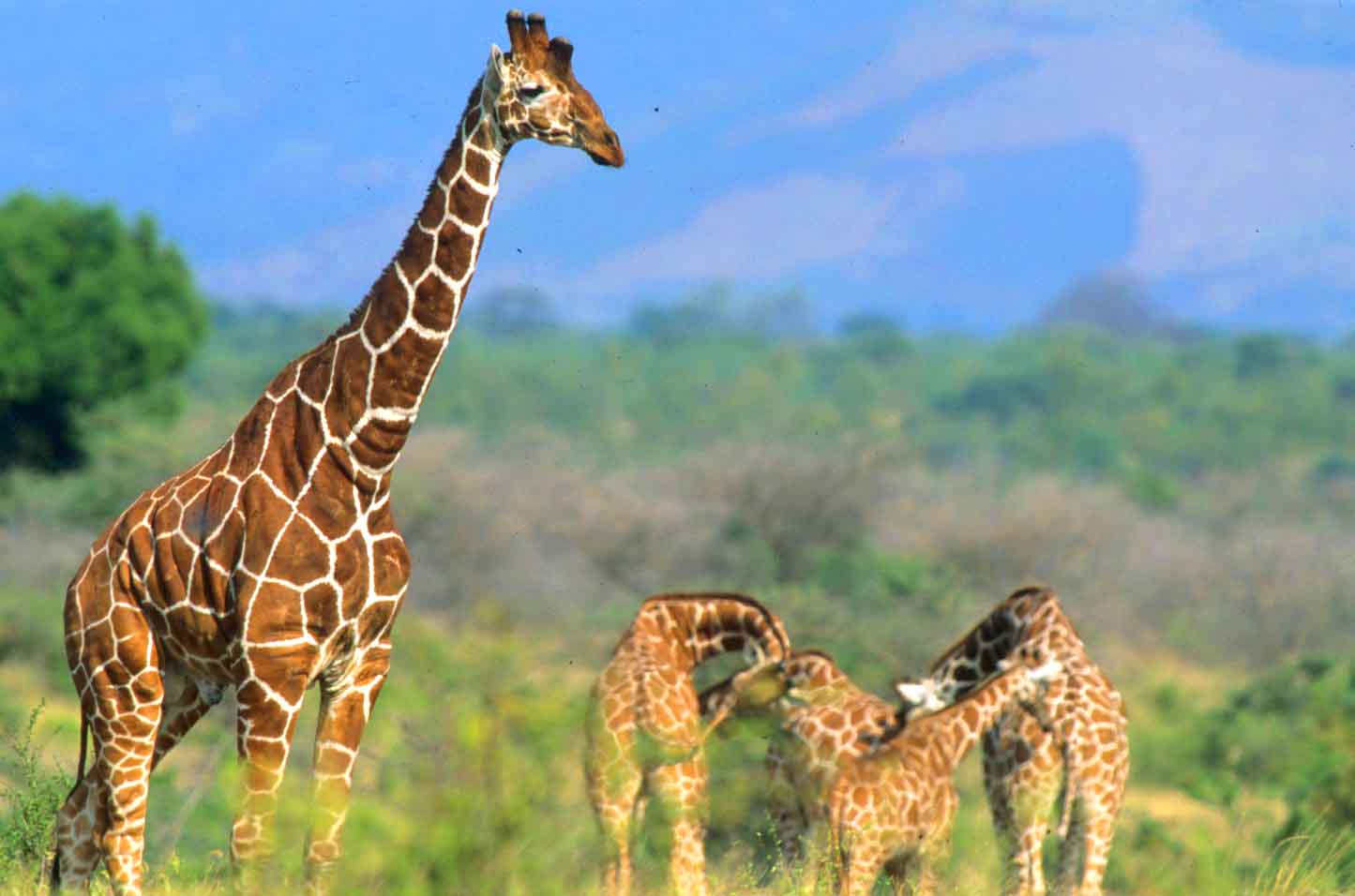Meru National Park in Kenya, Lodges, Wildlife
Meru National Park, located in Meru, Kenya, is a hidden gem that offers an authentic African safari experience. The Park, situated in the Eastern part of the country, approximately 350 kilometers from Nairobi, is named after the Meru tribe, who inhabit the surrounding areas. Covering an area of over 870 square kilometers, the Park is home to an array of wildlife, including rare species not found in other parks. Meru National Park was established in 1966 and gained international fame through the book and movie “Born Free,” which chronicled the life of Joy and George Adamson and their work in the Park.
The Park also boasts a diverse topography featuring verdant forests, vast grasslands, meandering rivers, and rocky outcrops. The Park’s centerpiece is the imposing Mount Kenya, Africa’s second-highest peak, which provides a stunning backdrop to the Park’s natural beauty.
The Park is easily accessible by road, with a journey from Nairobi taking approximately 5 hours. The Park is open throughout the year, with the best time to visit is during the dry season from June to October.
Meru National Park Activities
There is a wide range of fun activities one can engage in while at Meru National Park, including;
- Game Drives and Safaris: Embarking on a game drive or safari in Meru National Park is a thrilling adventure. Experienced guides lead visitors through the Park’s rugged terrain, unveiling its hidden treasures and ensuring memorable wildlife encounters. The Park offers day and night game drives, allowing for a comprehensive exploration of its inhabitants.
- Nature Walks and Hiking: For a closer encounter with nature, guided nature walks, and hikes are available within the Park. These activities offer a chance to explore the Park on foot, accompanied by knowledgeable guides who provide insights into the area’s flora, fauna, and cultural history.
- Cultural Experiences: Meru National Park is not only a sanctuary for wildlife but also a place where cultural heritage thrives. Visitors can engage with local communities, learning about their traditions, crafts, and way of life. This interaction provides a deeper understanding of the region’s rich cultural tapestry.
The Meru National Park also has a variety of sights and features to discover. In addition to its breathtaking landscapes and diverse species, the Park is home to world-class sites, including Adamson’s Fall, the Tana River, and the constantly brilliant Mt. Kenya vistas. The splendor of the Park’s marshes also leaves us speechless. Most of the wetlands are found in the Park’s northern region.
There are some permanent wetlands in the region, including the Bwatherongi, Mururi, and Malika swamps. The marshes help during the dry seasons for thirsty creatures hunting for water and tourists since the swamps make great places to see wildlife at that time.
The Meru Rhino Sanctuary is unquestionably the most significant attraction of all. The sanctuary is located on the western side of the Park’s main gate on an 80km2 parcel of land with good security where more than 20 white and 20 black rhinos can be found.
To fully immerse yourself in the wonders of Meru National Park, it’s recommended to embark on guided game drives led by experienced rangers. These game drives offer an opportunity to witness the Park’s wildlife up close while enjoying the stunning landscapes. The Park’s vastness ensures you can explore different areas, increasing your chances of spotting various animals. Additionally, guided nature walks, bird-watching excursions, and cultural visits to local communities can enhance your overall experience, providing a deeper understanding of the region’s rich heritage.
Wildlife in Meru National Park
Meru National Park is home to an extensive range of wildlife, which offer its visitors an unforgettable experience. Some of the wildlife found in the Park include;
- The Big Five: Meru National Park is home to a rich and varied array of wildlife, including the iconic Big Five: elephants, lions, leopards, rhinoceroses, and buffalo. Visitors have the opportunity to witness these majestic creatures in their natural habitat, as well as a host of other fascinating species.
- Unique Species: Apart from the Big Five, Meru National Park shelters an impressive diversity of wildlife, such as Grevy’s zebras, reticulated giraffes, gerenuks, cheetahs, and over 400 species of birds, and the gerenuk.
The Park’s diverse habitats provide a thriving environment for these remarkable animals, making it a haven for nature enthusiasts and birdwatchers.

Accommodation in Meru National Park
Meru National Park has several accommodation options, ranging from budget-friendly campsites to luxury lodges.
From luxury lodges to tented camps, visitors can immerse themselves in the tranquility of the Park while enjoying modern amenities and personalized services.
Some notable Lodges around Meru National Park are worth mentioning, including Elsa’s Kopje, named after the lioness in “Born Free,” which provides a luxurious retreat with stunning views. Other notable lodges include Rhino River Camp, Offbeat Meru Camp, and Leopard Rock Lodge,
Budget-friendly options include Murera Gate Guesthouse and Meru Guest House, which offer comfortable and affordable accommodations.
Hotels in Meru National Park
Meru National Park has several hotels within its vicinity that cater to visitors that prefer to stay in a hotel outside the Park. Meru town offers several options for accommodation. Some popular hotels include Meru Greens, Meru Slopes, and Meru Paramount. These hotels offer comfortable and affordable accommodation, making them a popular choice for visitors to the Park.
Meru National Park Reviews
Meru National Park has received numerous positive reviews from visitors who have experienced the Park’s beauty and wildlife. Visitors praise the Park’s diversity of wildlife, with some saying it is better than other more popular parks such as Maasai Mara. The Park’s accommodation options also receive positive reviews, with visitors praising the luxurious lodges and budget-friendly options.
The Park’s diversity of wildlife, accommodation options, and accessibility make it an excellent choice for those looking for a less crowded park. With its stunning landscapes and an array of wildlife, Meru National Park is a must-visit destination for any wildlife enthusiast.
Meru National Park FAQs
What is the best time to visit Meru National Park?
The best time to visit Meru National Park is during the dry season, which typically runs from June to September and January to February. This period offers better wildlife sightings and easier access to the Park’s attractions.
What wildlife can be found in Meru National Park?
Meru National Park is home to a wide range of wildlife, including elephants, lions, leopards, buffalos, rhinoceros, giraffes, zebras, cheetahs, hyenas, hippos, crocodiles, and over 400 species of birds.
Are there any endangered species in Meru National Park?
Yes, Meru National Park is known for its efforts in conserving endangered species. The Park is home to a population of black rhinos, which are endangered, and conservation programs are in place to protect these magnificent creatures.
What activities can visitors engage in at Meru National Park?
Visitors to Meru National Park can enjoy various activities, including game drives, guided nature walks, bird watching, cultural visits to local communities, and even fishing in designated areas.
Are there any accommodations available within the Park?
Yes, Meru National Park offers a range of accommodation options within its boundaries. These include luxury lodges like Elsa’s Kopje and Rhino River Camp and tented camps such as Leopard Rock Lodge and Ikweta Safari Camp.
Can visitors go on guided game drives in Meru National Park?
Yes, guided game drives are available in Meru National Park. Experienced rangers lead these drives, taking visitors through different areas of the Park to spot wildlife and explore the stunning landscapes.
Are there any restrictions or regulations for visiting Meru National Park?
Yes, specific regulations are in place to ensure the preservation and safety of the Park. Visitors are expected to adhere to park rules, such as staying on designated roads, not littering, and maintaining a safe distance from wildlife.
What is the Climate at the Meru National Park?
During the dry season, the hot weather is at 30 degrees, to be exact, with minimum humidity experienced during the day while the nights are colder. The rainy season falls in April and May, with the annual rainfall averaging at 350mm.





